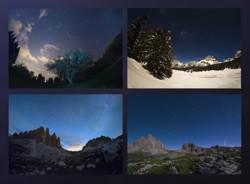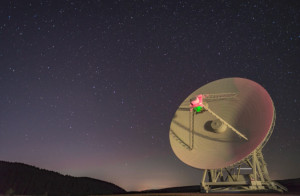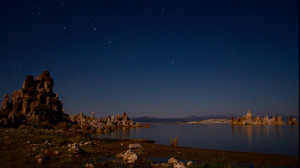Glossary term: Polaris
Description: Polaris is the nearest bright star (within one degree) to the celestial North Pole. Its official designation is α Ursae Minoris, but it is commonly known as Polaris, the North Star, or the Pole Star. All the stars of the northern hemisphere appear to rotate around it, so it provides an excellent fixed point from which to perform measurements for navigation and astrometry. Its elevation above the horizon gives the approximate latitude of the observing site. However, its position on the celestial sphere is slowly changing due to the precession of the rotation axis of Earth, so in several centuries Polaris will not indicate the location of the celestial North Pole anymore.
Polaris is a triple star system, composed of the primary, a yellow supergiant designated Polaris Aa, in orbit with a smaller companion, Polaris Ab, a very close main sequence star; the pair has a wide companion, Polaris B, a main sequence star orbiting at a distance of 2400 astronomical units (the orbital period is about 29.3 years). Polaris B can be resolved with a modest telescope. The Hubble Space Telescope was able to resolve all three members of the Polaris ternary system. The apparent visual magnitude of Polaris fluctuates because Polaris Aa is a Cepheid variable. The Polaris system is about 447 light years from Earth.
Term and definition status: This term and its definition have been approved by a research astronomer and a teacher
The OAE Multilingual Glossary is a project of the IAU Office of Astronomy for Education (OAE) in collaboration with the IAU Office of Astronomy Outreach (OAO). The terms and definitions were chosen, written and reviewed by a collective effort from the OAE, the OAE Centers and Nodes, the OAE National Astronomy Education Coordinators (NAECs) and other volunteers. You can find a full list of credits here. All glossary terms and their definitions are released under a Creative Commons CC BY-4.0 license and should be credited to "IAU OAE".
Related Media
Dreamlike Starry Sky and Airglow
Credit: Likai Lin/IAU OAE
License: CC-BY-4.0 Creative Commons Attribution 4.0 International (CC BY 4.0) icons
Big Dipper in Four Seasons
Credit: Giorgia Hofer/IAU OAE
License: CC-BY-4.0 Creative Commons Attribution 4.0 International (CC BY 4.0) icons
Big Dipper and Comet Neowise C2020 F3
Credit: Giorgia Hofer/IAU OAE (CC BY 4.0)
License: CC-BY-4.0 Creative Commons Attribution 4.0 International (CC BY 4.0) icons
The Big Dipper with the Sardinia Radio Telescope SRT
Credit: Antonio Finazzi/IAU OAE (CC BY 4.0)
License: CC-BY-4.0 Creative Commons Attribution 4.0 International (CC BY 4.0) icons
Big Dipper Over the Mono Lake
Credit: Fabrizio Melandri/IAU OAE (CC BY 4.0)
License: CC-BY-4.0 Creative Commons Attribution 4.0 International (CC BY 4.0) icons
The Rotating Planet
Credit: Jianfeng Dai/IAU OAE (CC BY 4.0)
License: CC-BY-4.0 Creative Commons Attribution 4.0 International (CC BY 4.0) icons
Star Trails of the Forbidden City
Credit: Stephanie Ziyi Ye/IAU OAE (CC BY 4.0)
License: CC-BY-4.0 Creative Commons Attribution 4.0 International (CC BY 4.0) icons
Related Activities
Navigating with the Kamal – Northern Hemisphere
astroEDU educational activity (links to astroEDU website) Description: How did Arabian sailors navigate at sea?License: CC-BY-4.0 Creative Commons Attribution 4.0 International (CC BY 4.0) icons
Tags: History , Geography , Coordinates , Celestial navigation , Arabia , Kamal Age Ranges: 14-16 , 16-19 Education Level: Middle School , Secondary Areas of Learning: Modelling , Social Research Costs: Low Cost Duration: 1 hour 30 mins Group Size: Group Skills: Analysing and interpreting data , Asking questions , Communicating information , Developing and using models , Planning and carrying out investigations















